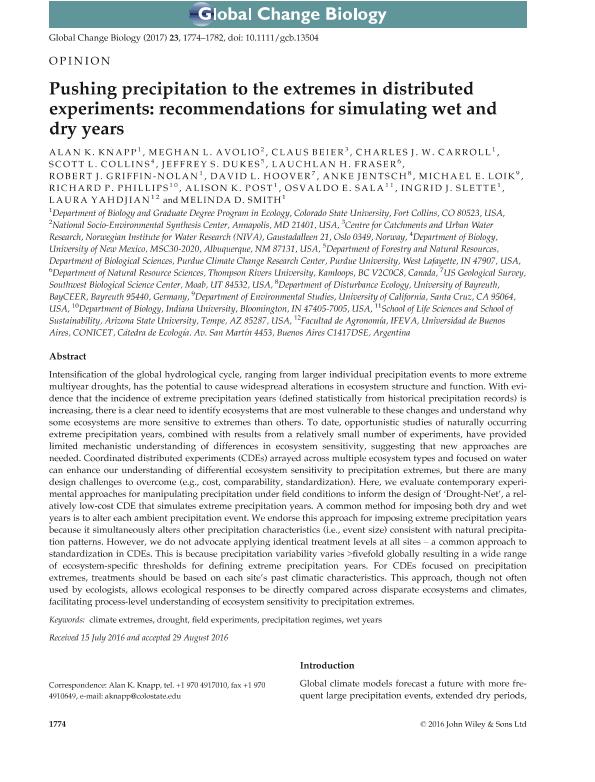Artículo
Pushing precipitation to the extremes in distributed experiments: recommendations for simulating wet and dry years
Knapp, Alan K.; Avolio, Meghan L.; Beier, Claus; Carroll, Charles J. W.; Collins, Scott L.; Dukes, Jeffrey S.; Fraser, Lauchlan H.; Griffin Nolan, Robert J.; Hoover, David L.; Jentsch, Anke; Loik, Michael E.; Phillips, Richard P.; Post, Alison K.; Sala, Osvaldo Esteban ; Slette, Ingrid J.; Yahdjian, María Laura
; Slette, Ingrid J.; Yahdjian, María Laura ; Smith, Melinda D.
; Smith, Melinda D.
 ; Slette, Ingrid J.; Yahdjian, María Laura
; Slette, Ingrid J.; Yahdjian, María Laura ; Smith, Melinda D.
; Smith, Melinda D.
Fecha de publicación:
05/2017
Editorial:
Wiley Blackwell Publishing, Inc
Revista:
Global Change Biology
ISSN:
1354-1013
Idioma:
Inglés
Tipo de recurso:
Artículo publicado
Clasificación temática:
Resumen
Intensification of the global hydrological cycle, ranging from larger individual precipitation events to more extreme multiyear droughts, has the potential to cause widespread alterations in ecosystem structure and function. With evidence that the incidence of extreme precipitation years (defined statistically from historical precipitation records) is increasing, there is a clear need to identify ecosystems that are most vulnerable to these changes and understand why some ecosystems are more sensitive to extremes than others. To date, opportunistic studies of naturally occurring extreme precipitation years, combined with results from a relatively small number of experiments, have provided limited mechanistic understanding of differences in ecosystem sensitivity, suggesting that new approaches are needed. Coordinated distributed experiments (CDEs) arrayed across multiple ecosystem types and focused on water can enhance our understanding of differential ecosystem sensitivity to precipitation extremes, but there are many design challenges to overcome (e.g., cost, comparability, standardization). Here, we evaluate contemporary experimental approaches for manipulating precipitation under field conditions to inform the design of ‘Drought-Net’, a relatively low-cost CDE that simulates extreme precipitation years. A common method for imposing both dry and wet years is to alter each ambient precipitation event. We endorse this approach for imposing extreme precipitation years because it simultaneously alters other precipitation characteristics (i.e., event size) consistent with natural precipitation patterns. However, we do not advocate applying identical treatment levels at all sites – a common approach to standardization in CDEs. This is because precipitation variability varies >fivefold globally resulting in a wide range of ecosystem-specific thresholds for defining extreme precipitation years. For CDEs focused on precipitation extremes, treatments should be based on each site's past climatic characteristics. This approach, though not often used by ecologists, allows ecological responses to be directly compared across disparate ecosystems and climates, facilitating process-level understanding of ecosystem sensitivity to precipitation extremes.
Palabras clave:
Climate Extremes
,
Drought
,
Field Experiments
,
Precipitation Regimes
,
Wet Years
Archivos asociados
Licencia
Identificadores
Colecciones
Articulos(IFEVA)
Articulos de INST.D/INV.FISIOLOGICAS Y ECO.VINCULADAS A L/AGRIC
Articulos de INST.D/INV.FISIOLOGICAS Y ECO.VINCULADAS A L/AGRIC
Citación
Knapp, Alan K.; Avolio, Meghan L.; Beier, Claus; Carroll, Charles J. W.; Collins, Scott L.; et al.; Pushing precipitation to the extremes in distributed experiments: recommendations for simulating wet and dry years; Wiley Blackwell Publishing, Inc; Global Change Biology; 23; 5; 5-2017; 1774-1782
Compartir
Altmétricas



